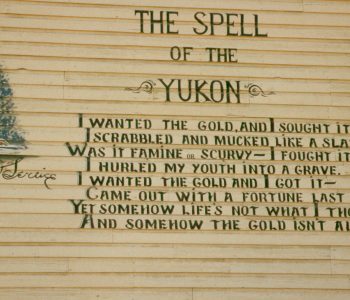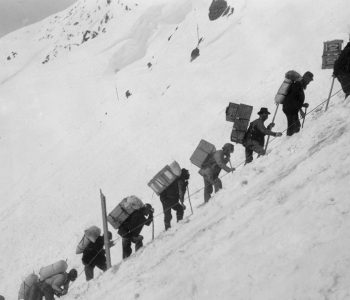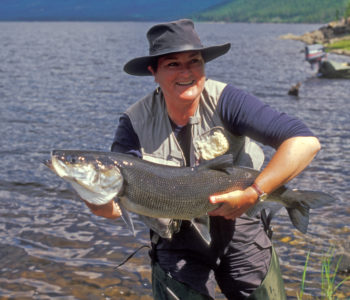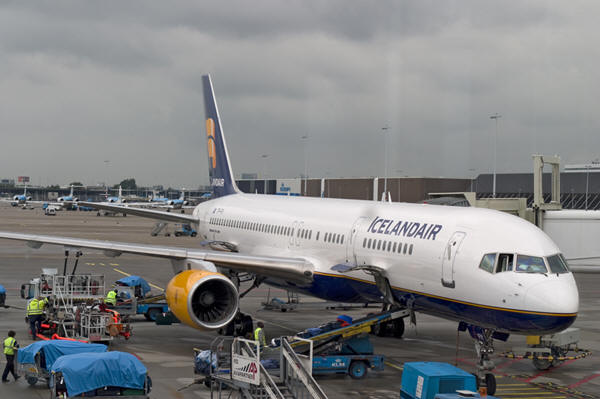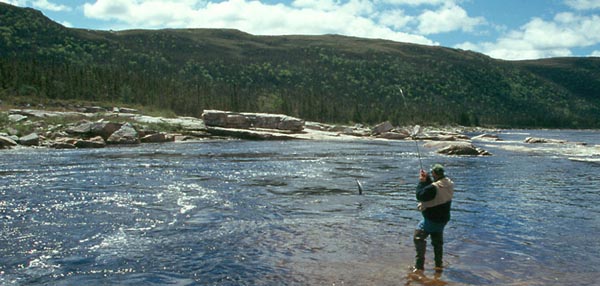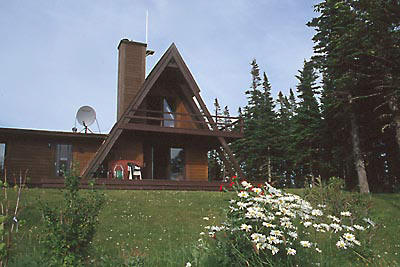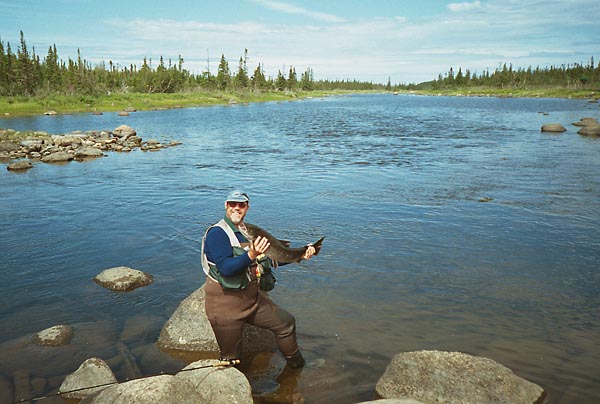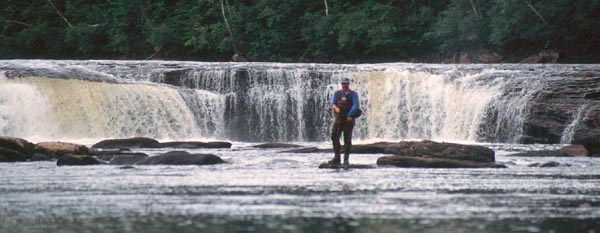
Land of magic and mystery
The Yukon Territories: by Hans van Klinken
There’s a land where the mountains are nameless,
And rivers all run God knows where;
There are lives that are erring and aimless,
And deaths that just hang by a hair.
There are hardships that nobody reckons;
There are valleys unpeopled and still;
There’s a land-oh, it beckons and beckons,
And I want to go back-and I will.
From the “Spell of the Yukon” by Robert Service

In the year 2000 a lot of people including myself wanted to do something really special. Personally I just wanted to have a good trip as I went through some serious medical problems over the last few years. So I have decided to do everything now while I am still capable. I know a lot of people who say, “I will travel when I am retired” but unfortunately not many of them make it. When I make up my mind to do something it is very hard to convince me otherwise. I always try to plan well and follow through to the finish and make it as good as possible. There were three locations in my mind to visit and I started researching them in October 1999. One of the options was going Down Under to New Zealand, another choice was the Eagle River in Labrador and then there was my dream to catch the Arctic grayling. The trip to New Zealand became too complicated to organize because it didn’t fit into my work schedule. I have been in Labrador before so another North American destination become more and more interesting. I think there were a few good reasons that I finally chose for the Yukon Territories. I never had been there before and we had heard extremely good reviews when we visited the northern part of British Columbia in 1998. The travel to the Yukon has been improved enormously and checking it out was easy. Yukon has a lot of Arctic grayling and is less crowded then BC, whose population and city sizes has amazed us quite a lot. I also discovered that fly-fishing in the Yukon is pretty young too and people who have been there have told me that there wouldn’t be any fishing pressure at all. There were even places that have never been fished by fly before.

Another important reason that made my choice much easier was the direct flight from Frankfurt to Whitehorse. I just love straight connections and I even have now a more powerful argument for it when we saw how two other Dutch people, who arrived together with us, lost their entire luggage at Vancouver airport just because they had a very complicated journey with several fights. We felt very sorry for them because just a few hours later their Alaska float trip had already started and they were completely desperate. A direct flight is really the best option and I think the Yukon will get more popular to fly fishers especially now that Air Transat offers this unique opportunity. We also advice people to take advantage of Air Transat’s great offer and go by train to Frankfurt just the day before because the plane leaves very early in the morning. We had a wonderful flight and can highly recommend it. A lot of people don’t realise it but a good charter company will transport your sport fishing equipment free of extra charge, you only have to ask, explain and tell them about it when you are making your booking. It is fair too because I once had a lot of problems when somebody didn’t have to pay for his golf equipment while we had to pay a lot for our fishing gear. So our Y2K destination was the Yukon Territories and let me start by telling you something about this land of magic and mystery first!

Yukon “The land of magic and the mystery”
I have started this story with a part from a poem. I did that for a reason. Firstly I like this poem and secondly this is exactly how I felt after I returned back home. I will go back there this year whatever happens. I am not very good with poems but believe me when you are in the Yukon there are two minor things you will get into whether you like it or not. The first is the Klondike Gold rush and secondly the words of Robert Service. When I prepared myself for this trip I read a special book about the Yukon. It’s called “Land of the Midnight sun” It have been written 45 years ago but I don’t think any other book can describe the history of the Yukon better.
The Yukon Territories covers about 483.450 square kilometres, of which only one percent is inland water and more then half is wooded. That’s almost the size of Spain except that there is a population of 32.000 in the entire Yukon and 23,000 of them are settled in Whitehorse. I think this will show you well how sparse this Territory is populated. There are several explanations about the origin of the Territories name. John Bell, the first European who stood on the banks of the upper Yukon River, said that the Indians called it Yuocon, or White Water River. In the old native language of the Kutchin “Yu-kun-ah”, means Great River. Whatever the truth will be it finally turned out into The Yukon!

From the northern coast at sea level the land rises up to 6000 metres at the top of Mount Logan in the southwest of the Yukon. For people who love mountains this is probably the most beautiful area in the Yukon. Most of the Territory is mountainous and the chains running from the northwest to the southeast. Tourist will discover quickly that the land has many contrasts. Huge broad valleys will give some extra dimension and will offer you some awesome photographic possibilities and great views. It also makes it possible to see the wildlife much better. We already spotted our first grizzly after driving just 15 minutes away from Whitehorse. It is this wide-open sight that makes the Yukon so much different from many other mountainous countries.
Geographical you can divide the Yukon into taiga and tundra, which I really love due to my big outdoor experiences from the past. The taiga including the forests and has a sub arctic zone, the tundra is the vast rocky plain in the north, where extreme temperatures has stunted the vegetation. The summers are relatively warm with temperature easily reaching 25º C and even more. During our stay the highest temperature was about 28 degrees but we also were able to explore a big snowstorm at the 12th of July. People told me that in wintertime the temperatures easily can be varied between + 4 and minus 50 ºC depending the latitude. The weather in the Yukon can change quickly and mountain winds have a great influence at it. At the 5th of July we had such an experience in which the weather changed in just 5 minutes and made it almost impossible for us to cross a lake by boat.
Above the Arctic Circle Yukon is known as the “Land of the midnight sun” which we experienced and enjoyed well in the northern part of Scandinavia for many years. Although we known the northern lights from Scandinavia too it is nothing compared with the much more powerful Aurora Borealis you can experience in the Yukon. I know several people who specially going to the Yukon to see this natural mystery year after year.

Boreal forest
Canada’s boreal forest is part of a great northern circumpolar band of mostly coniferous forests extending across the sub arctic regions of Russia, Scandinavia and North America. Different habitats exist within the forest. White spruce, the most common tree species, grows in a wide Boreal forest range of moisture and soil conditions, and is largest along rivers. Lodge pole pines grow in the drier areas with well-drained soil. These areas often support large tracts of lichens, an important winter food for woodland caribou. Trembling aspen grow well on open slopes and in areas regenerating after fire. Aspens have a smooth, whitish-green chalky bark but are famous for the leaves that “tremble” with the slightest breeze. This is one of the many things that make Yukon so mysterious. Black spruce grows in areas with poorly drained wet soil, often over permafrost. The permafrost itself is hard to recognize but I know it is there and you can feel it like I did in northern Finland too. Deep-rooted balsam poplars grow along river corridors and in moist draws, where their roots are kept wet year-round. Dead trees and fallen logs provide shelter for many small animals, such as voles and red squirrels, which themselves are the main diet of pine marten. Listen for the chattering of red squirrels and the movement of grouse on the forest floor. The vegetation is less dense as we explored in Atlantic Canada and BC and that made hiking, fly fishing and wildlife spotting much easier.
Still water of the Yukon
Still water includes some wetlands and lakes. Wetlands include shallow bodies of water with heavy growth of aquatic and shoreline vegetation. Many orchids grow in the moist soil surrounding wetlands and bloom in June and July. Wetlands with dense aquatic vegetation are good habitats for Northern Pike (known locally as Jackfish) and moose. We knew that fly-fishing for pike in the Yukon was excellent but we never realised that it was much better then we ever could imagine. The pike can be rather big too. Wetlands provide nesting, feeding and escape habitat for waterfowl such as Lesser Scaup, Northern Pintail, Green-winged Teal, and American Widgeon. Muskrat push-ups, seen on the surface after the ice forms, remain throughout the winter and spring. These are feeding and resting platforms built by muskrats so they can gather food further from their bank dens than they would otherwise be able to reach. Pointed stumps and dome-shaped lodges with nearby underwater branch piles are signs that beavers are nearby.

In summer, wetlands are important feeding areas for moose and provide them with escape routes from attacks by predators such as grey wolves and grizzly bears. The summer diet of moose consists of aquatic vegetation along with willow buds and leaves. Yellow Warblers, waxwings and many other species of songbirds nest in the vegetation surrounding wetlands. Some birds feast on insects that emerge from the water during June and July. Larger lakes provide abundant stocks of fish for Ospreys and Bald Eagles. These lakes are the preferred habitat of the Common Loon, well known for its haunting and mystic call. Lakes also provide excellent habitats for Lake Trout, and different species of Whitefish. In fall, they become staging areas for waterfowl where hundreds of birds can sometimes be seen.
Flora and fauna
The Yukon is known to be home to four species of amphibians, 61 species of mammals, 279 species of birds, 1,150 different kinds of plants and over 1,500 species of insects. The insects are an important feeding source for the birds and each spring and fall the sky over Yukon comes alive when millions of birds migrating from their winter stay up to their nesting grounds all over the Yukon. The famous Porcupine caribou herd, which is, estimate at 120,000 animals winters in central Yukon. Across the Territory tourist frequently spot Dall sheep, black and grizzly bears, moose, foxes, caribou, coyotes, marmots, porcupines, squirrels and many birds. We saw them all in just one single sight seeing trip from only a few hours. The fauna is amazing especially when you are able to make a trip in the highlands. We spotted deep blue lupine, yellow potentilla, monkshood, pink flowered wintergreen and Arctic poppy at many places. Beside the roads you can find pink fireweed, crimson purple bear root and feathery foxtail grasses swaying gently by the mountain winds.

The streams and rivers
Many species of fish and birds inhabit rivers and streams. It’s a perfect area to get one with nature. Arctic Grayling and whitefish are common species in most of Yukon Rivers. They attract many predators to these areas as well. A mink’s diet, for example, includes muskrat, mice, snowshoe hare, fish, frogs and sometimes birds. River otters prefer fish but will occasionally forage on river bottoms for aquatic insects or consume birds, muskrats, voles and shrews. Mink and river otters may raise their families in abandoned muskrat and beaver bank dens. Moose are also attracted to river corridors to feed and we have seen dozens while fishing and travelling by plane or boat. Harlequin Ducks nest on the banks of fast flowing rivers and feed on aquatic invertebrates, as does the American Dipper. The Spotted Sandpiper probes exposed sandbars and muddy shores for buried invertebrates. In most of the steep riverbanks, colony-nesting Bank Swallows can be found. River sandbars are ablaze with the colour of river beauty or dwarf fireweed in July and August. Floating quietly downriver in a canoe may reveal a bear that has come to feed on lush grasses and horsetails. A grey wolf may serenade the night sky close to your campsite. Be wary of grizzly bears especially near noisy streams and rivers. Close encounters seem more frequent when salmon are spawning in late summer and fall but keep your eyes wide open at all times and I am talking about my own experience. It’s a big experience if a grizzly ever has chased you.

A trip down one of the Yukon’s many beautiful rivers or on a quiet lake may be the best way of seeing a variety of wildlife species. Several lodges rent canoes or you can organize a trip through a company specializing in canoe and rafting trips. Consult Canada’s Yukon, the Official Vacation Guide for a list of these companies. I highly recommending a guided trip but if you have a lot outdoor and want to travel down one of Yukon Rivers on your own, it would be wise to research your trip very well. The descriptions of rivers in this guide are not complete so do not rely entirely on this source. Other books, however, can provide you with detailed information about the dangers and difficulties encountered on specific Yukon rivers. Please ensure that you have the proper first aid and river rescue equipment, as well as ample clothing and food to complete your trip safely. Never fish, hike or travel alone in the Yukon wilderness either.

Fly Fishing
If fly fishing is your passion like it is for us then you will be amazed how many streams and rivers will offer some awesome fly fishing. We highly promote catch and release and using barbless hooks. Before you can wet your flies you must have a valid fishing license to fish in Yukon waters. Licenses are available at community Renewable Resources offices, the Fisheries and Oceans Canada office, most highway lodges, sporting goods stores, hardware and general stores and gas stations. If you plan any fly-fishing for salmon in the Yukon, you must purchase a Salmon Conservation Catch Card in addition to a Yukon fishing license. In spite of poor controls be a good tourist and buy your license they are cheap anyway. A Catch Card can be obtained at the same place where you purchase your fishing license. Fly-fishing in national parks requires a National Park Fishing License as well. These are available at the Kluane National Park Reserve Visitor Reception Centre or the Parks Canada office in Whitehorse.

With special thanks to the Yukon Department of Tourism for their great help to realize this story and for their permission to use some information and background from the Yukon’s wildlife viewing guide and several other information packages.
